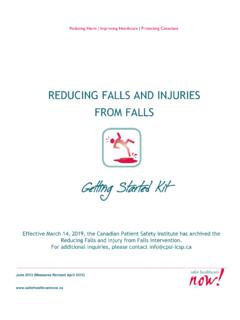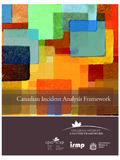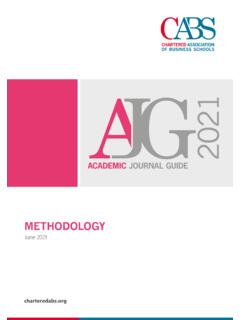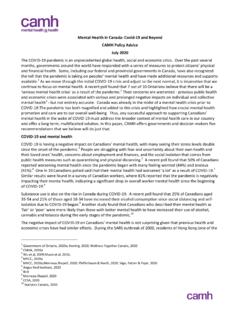Transcription of Canadian Disclosure Guidelines - Patient Safety Institute
1 Canadian Disclosure Guidelines BEING OPEN WITH PATIENTS AND FAMILIES. Safe care accepting no less 1. Soins s curitaires n'acceptons rien de moins Canadian Patient Safety Institute Institut canadien pour la s curit des patients Suite 1414 , 10235 - 101 Street Bureau 410, 1150 chemin Cyrville Edmonton, AB, Canada Ottawa, ( ontario ) K1J 7S9. T5J 3G1 T l phone: 613-730-7322. Toll Free: 1-866-421-6933 T l copieur: 613-730-7323. Phone: 780-409-8090. Fax: 780-409-8098. 2011 Canadian Patient Safety Institute All rights reserved. Permission is hereby granted to redistribute this document, in whole or part, for educational, non-commercial purposes providing that the content is not altered and that the Canadian Patient Safety Institute is appropriately credited for the work, and that it be made clear that the Canadian Patient Safety Institute does not endorse the redistribution.
2 Written permission from the Canadian Patient Safety Institute is required for all other uses, including commercial use of illustrations. Suggested Citation: Disclosure Working Group. Canadian Disclosure Guidelines : being open and honest with patients and families. Edmonton, AB: Canadian Patient Safety Institute ; 2011. This publication is available as a free download from: The Canadian Patient Safety Institute would like to acknowledge funding support from Health Canada. The views expressed here do not necessarily represent the views of Health Canada. ISBN: 978-1-926541-38-9 (print). ISBN: 978-1-926541-36-5 (online). 2. 2011 Disclosure WORKING GROUP. Brent Windwick Working Group Chair Diane Aubin Canadian Patient Safety Institute Paula Beard Canadian Patient Safety Institute Mike Boyce Healthcare Insurance Reciprocal of Canada Donna Davis Patients for Patient Safety Canada Orvie Dingwall University of Manitoba Sherry Espin Ryerson University Beth Kiley Capital District Health Authority (Nova Scotia).
3 Christina Krause British Columbia Patient Safety & Quality Council Amy Nakajima The Ottawa Hospital Gordon Wallace Canadian Medical Protective association 2008 Disclosure WORKING GROUP 2008 affiliations Brent Windwick Working Group Chair Paula Beard Canadian Patient Safety Institute Elaine Borg Canadian Nurses Protective Society Mike Boyce Healthcare Insurance Reciprocal of Canada Pierre Deschamps National Council on Ethics in Human Research Ward Flemons Health Quality Council of Alberta (HQCA) from Sept/07. Ronald Guse Manitoba Pharmaceutical association , Canadian Pharmacists association , Canadian Society of Hospital Pharmacists, National association of Pharmacy Regulatory Authorities Carolyn Hoffman Canadian Patient Safety Institute Beth Kiley Canadian Healthcare association Katharina Kovacs Burns Public representation, Best Medicines Coalition Christina Krause HQCA representative May/06-Aug/06, Special Advisor from Sept/06.
4 Susan Kwolek Canadian College of Health Services Executives Patricia Lefebvre Canadian Pharmacists association , Canadian Society of Hospital Pharmacists, National association of Pharmacy Regulatory Authorities Mary Marshall Special Advisor (Legal support). Heather McLaren Manitoba Health Jessica Peters Canadian Council of Health Services Accreditation Sylvia Ralphs-Thibodeau Canadian Nurses association from Nov/06. Aviva Rubin ontario Ministry of Health and Long-term Care H l ne Sabourin Canadian Nurses association , May 06-Oct 06. Jill Taylor HQCA representative Aug/06-Mar/07, Special Advisor from Mar/07. Trevor Theman Federation of Medical Regulatory Authorities Canada Dawn Vallet Canadian Patient Safety Institute Gordon Wallace Canadian Medical Protective association W.
5 Todd Watkins Canadian Medical association The members of the Disclosure Working Group and the CPSI acknowledge the staff and CEO of the Health Quality Council of Alberta for their leadership in developing the Disclosure of Harm to Patients and Families: provincial framework (2006), and appreciate the previous Disclosure Working Group's efforts in creating the original documents on which these revisions are based. We would also like to recognize the key contributions of the following individuals: Anne Matlow, Elaine Orrbine, Denice Klavano, Robert Devitt, Margaret angus , Karima Bushra, Heather Loughlin and Tanya Goldberg. 3. A Patient 'S PERSPECTIVE. Disclosure should be based on principles of Patient Safety , openness, transparency, accountability and compassion.
6 When things go wrong, patients and families need to know what happened. We need to know what changes have been or will be made to prevent a similar event in the future. We need to hear the words I'm sorry from those most involved in the event and, where appropriate, we need to see and hear the organization accept responsibility for its part in the event. When patients and families sense that information is being withheld, we lose trust, and we are more anxious, fearful and angry. We do not expect perfection, but we do expect honesty, justice and shared learning when an incident happens. We also expect to be a part of the process of finding out what happened. Disclosing a Patient Safety incident with openness, honesty and compassion shows respect for the Patient and family.
7 It shows that the organization is worthy of our trust and that the needs of the Patient and family are paramount. When the loss from the harm is irreplaceable, reparation means far more than financial compensation. It means striving to understand the needs of those who have been harmed and doing everything possible to provide for those needs. Donna Davis Co-chair, Patients for Patient Safety Canada 4. TABLE OF CONTENTS. Foreword 6. Message from Hugh MacLeod 6. Message from Brent Windwick 7. Message from Patients for Patient Safety Canada* 8. Introduction 9. Guiding Principles 10. Importance of Disclosure 10. Patient Perspective 10. Ethical Perspective 11. Healthcare Organization Perspective 11. A Few Words on Words 11.
8 International Classification for Patient Safety 11. Avoiding the Use of Error in the Context of Disclosure 12. Use of the Term Patient 12. Scope of these Guidelines 13. Building the Foundation for Disclosure 18. Supporting Patients 15. Expense reimbursement 16. Supporting Healthcare Providers 16. Supporting Disclosure through a Just Culture 17. The Disclosure Process 18. A Word on Apology Saying Sorry 19. Circumstances When Disclosure Should Take Place 20. Stages of Disclosure 22. Preparing for Initial Disclosure 24. The Disclosure Team 24. The Role of Leadership/Management 25. What to Disclose 26. How to Disclose 27. Setting and Location 27. Documentation 27. Summary 28. Specific Circumstances 29.
9 Large Scale Disclosure 30. Multi- Patient Disclosure 30. Multi-jurisdictional Disclosure 31. Paediatric Patients 32. Patients with Mental Health Issues 32. Communication Issues 33. Language and/or Cultural Diversity 33. Research Settings 33. Appendices 34. Appendix A Recommended Readings 35. Appendix B Glossary 40. Appendix C Recommended Elements of a Disclosure Policy 41. Appendix D Checklist for Disclosure Process 42. Appendix E Patients for Patient Safety Canada Disclosure Principles 43. References 44. 5. FOREWORD. MESSAGE FROM HUGH MACLEOD. Chief Executive Officer Canadian Patient Safety Institute With the unveiling of our new strategic plan in 2010, the Canadian Patient Safety Institute made it clear that we are accepting no less than safe care.
10 We define a successful organization as one that will: Embrace prevention of all avoidable harm to patients as a core objective. Support all healthcare providers to make Safety a top priority in their work. Nurture and support a commitment to improvement at all levels of the organization. Achieve long periods of incident-free care without becoming complacent or overconfident. Adopt leading methods to measure, monitor and report on performance. This document, a revision of Disclosure Guidelines originally published in 2008, aims to help organizations achieve this success by being open and honest with patients and families about Patient Safety incidents. We hope these Guidelines will create new conversations about Disclosure , clarify how best to meet the needs of patients and families, and help align Disclosure policies across Canada.











